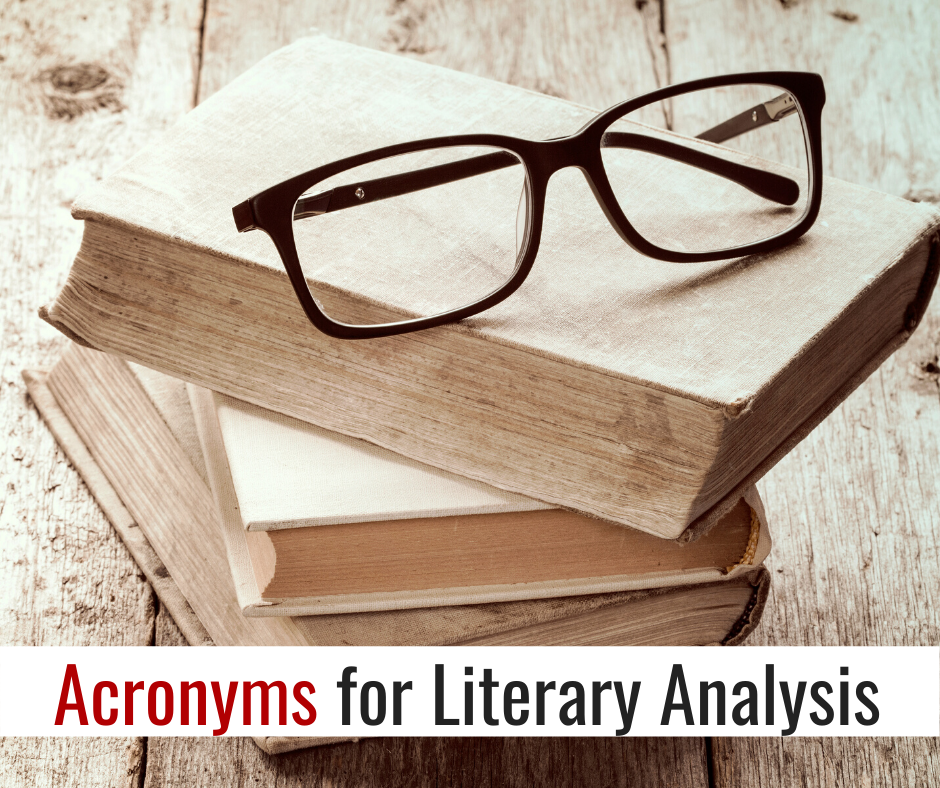Literary analysis is a particularly important skill in middle school and high school English Language Arts. In fact, all of our lessons in ELA center around analyzing literature-- from fiction to poetry to nonfiction. We use literary analysis as the vehicle for teaching reading, writing, speaking, and listening. There are so many approaches to teaching literary analysis, but what I didn’t realize is that there are so many acronyms that can be used to teach the literary analysis process.
Upon conducting a simple search for “TPCASTT,” I found so many other acronyms for literary analysis that I decided to compile them into a master list. Acronyms are effective mnemonic devices that enable us to remember information, and they make excellent tools to use in our classrooms to enhance student retention. That’s why teachers have created so many to help literary analysis acronyms to help students navigate the literary analysis process.
Take a look at the list below of acronyms for literary analysis. Some strategies work better for certain modes of writing while others work for any piece of literature. Check off the ones you’ve heard of or the ones you’ve used in your classes. Also see if you can make up your own acronym for literary analysis by focusing on how you teach the process and the steps that work best for your students.
Let’s get started with the list!
OPTIC (for analyzing visual art)—
Overview/ Parts of the Picture/ Title/ Interrelationships/ Conclusion
SMILE—
Structure/ Meaning/ Imagery/ Language/ Effect
SOLLIDD (great for analyzing rhetoric)—
Syntax/ Organization/ Literary Devices/ Levels of Discourse/ Imagery/ Diction/ Detail
PATTR—
Purpose/ Audience/ Tone/ Theme/ Rhetorical devices
WRITER—
Who/ What/ Rhythm & Rhyme/ Imagery/ Tone/ Effects/ Response
SCASI—
Setting/ Characters/ Action/ Style/ Idea
SLAPP—
Structure/ Language/ Audience/ Purpose/ Presentational Devices
LIST—
Language/ Imagery/ Structure/ Tone
FLIRTS—
Form/ Language/ Imagery/ Rhythm & Rhyme/ Tone/ Structure
TPCASTT (for poetry analysis)—
Title/ Paraphrase/ Connotation/ Attitude/ Shift/ Title/ Theme
TPFASTT (for poetry analysis)—
Title/ Paraphrase/ Figurative Language/ Attitude/ Shifts/ Title/ Theme
DIDLS—
Diction/ Imagery/ Details/ Language/ Sentence Structure
SOAPSTone—
Speaker/ Occasion/ Audience/ Purpose/ Subject/ Tone
SPOTTSS—
Subject/ Paraphrase/ Occasion & Organization/ Title/ Tone/ Theme/ Speaker/ Strategies
5S Strategy—
Key sentences/ Speaker/ Situation/ Shifts/ Syntax
SIFTT—
Symbols/ Images/ Figurative Language/ Tone & Theme
DUCATS—
Diction/ Unity (structure)/ Coherence (logic & organization)/ Audience/ Tone/ Syntax
PPSSSSTTT—
Paraphrase/ Purpose/ Structure/ Shift/ Speaker/ Spelling & Diction / Tone/ Theme/ Title
DITS (elements of tone)—
Diction/ Imagery/ Theme/ Style
TAPS—
Topic/ Audience/ Purpose/ Speaker
SLLIDDTOP—
Syntax/ Language/ Literary Devices/ Imagery/ Diction/ Detail/ Tone/ Organization/ Point of View
TWIST—
Tone/ Word Choice/ Style/ Theme
SMELL (for analyzing rhetoric)—
Sender/ Message/ Evidence/ Logic/ Language
Did you realize there were so many acronyms for literary analysis? And these don’t even include the acronyms for writing! Try using one or more of these acronyms with your students and let them decide which one(s) they like the best. This is a way to give students a voice in the process of analyzing literature. Alternatively, allow students to create their very own acronyms, and they can have fun with all the various combinations of skills involved in the process of literary analysis.
Do you have any acronyms to add to this list? I’d love to hear from you! Please leave a comment below.
Be sure to check out the FREE LIST of Acronyms for Literary Analysis by subscribing to the Bespoke ELA Freebie Library here.
YOU MIGHT ALSO LIKE:
Managing Makeup Work in the Secondary Classroom: Six Steps for Success!
The Writer's Notebook: Integrating Technology in Three Easy Steps
The Power of ONE: A Strategy for Growing Your TpT Shop
The Three Levels of Thinking: A Reading Strategy for Complex Texts
3 Annotations for Deeper Reading
Related Resource
About the Author
Meredith is the founder and creator of TeachWriting.org and Bespoke ELA. She has taught high school English for 10+ years in Dallas, Chicago, and New York City and holds a M.A. in Literature from Northwestern University. She has always had a connection to the written word-- through songwriting, screenplay writing, and essay writing-- and she enjoys the process of teaching students how to express their ideas. An avid tea drinker and anglophile, Meredith enjoys life with her husband, daughter, and sweet pups.





